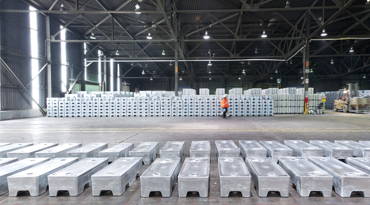Mining
It all starts with traces of zinc which can be found just about everywhere in the earth’s crust. Zinc is a natural resource.
Nyrstar gathers and ships zinc concentrate from mines all over the world to various ports close to our operations.
From there, train loads of zinc concentrate are transported to the sites to undergo a four-stage process of roasting, leaching and purification, electrolysis and casting.
1. Roasting
Raw materials – zinc concentrate and zinc oxides recycled from the steel industry – are fed into a fluid bed roaster. This is step one in the production process.
In the roaster, raw zinc materials are burned with air and are turned into calcine. Calcine looks like sand and has a temperature of 950 degrees Celsius.
The roasting process is fully automated and constantly monitored and controlled by operators from a control room
2. Leaching & Purification
Step two is pure chemistry. The produced calcine is dissolved in sulphuric acid during a process called leaching.
In order to produce a very pure zinc sulphate solution, we separate a wide range of other metals during this step as well: lead, gold, silver doré, copper, cadmium and cobalt.
The zinc sulphate solution consequently enters the stage of electrolysis: step three.
3. Electrolysis
In the electrolysis department, the zinc contained in the solution is deposited onto aluminum cathodes in a process called electrowinning. This happens by passing an electric current through cathodes and anodes.
The cathodes are removed from the cells and the zinc sheets are stripped from the cathodes and sent to casting. In casting, cathode zinc is melted in furnaces and the molten zinc is made into blocks and ingots.
The electrolysis stage is a fascinating process which takes a little over 22 hours.
Using large amounts of electricity, pure zinc is deposited on aluminum plates . These plates, which carry pure zinc, are lifted out of the cells.
Machines strip off the zinc and the empty plates are returned to the cells where the process starts all over again.
4. Melting and casting
As the fourth and last step, zinc is remelted and cast in various shapes and sizes - slabs, ingots and blocks - between 25 and 2500 kg.
Besides that, specific alloys are casted by adding a variety of alloying materials.
The finished zinc has many uses from construction, to transport, industrial machinery, communications, electronics and consumer products.
The main use of zinc around the world is in protecting steel from corrosion. Adding a thin layer of zinc is one of the most environmentally friendly ways to stretch the lifetime of a steel product by approximately 12 times.


